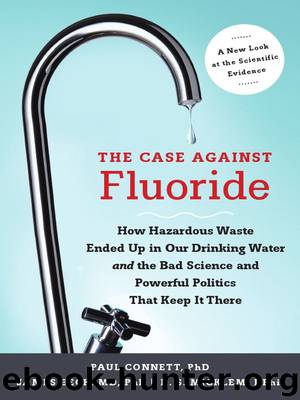The Case Against Fluoride by Paul Connett & James Beck & Spedding Micklem

Author:Paul Connett & James Beck & Spedding Micklem [Connett, Paul & Beck, James & Micklem, Spedding]
Language: eng
Format: epub
Tags: Health & Fitness, Health Care, Medical, Non-Fiction, Political Science, Public Health, Public Policy
ISBN: 9781603583138
Google: DEqDaoNTo2IC
Publisher: Chelsea Green Publishing
Published: 2010-10-06T23:00:00+00:00
•
19 •
Fluoride and the Kidneys,
and Other Health Issues
Two issues pertain to fluoride and the kidneys. The first is the possibility that fluoride can damage the kidneys, especially at high levels. The second is the fact that someone with poor kidney function has a limited ability to clear fluoride from the body, which would make that person more vulnerable to fluoride’s other toxic effects.
Fluoride Damage to the Kidney
With the exception of the pineal gland, the kidney accumulates more fluoride than all other soft tissues in the body. 1–3 It is well known that high doses of fluoride can damage the kidney after short periods of exposure—for example, to an anesthetic that contains fluorinated hydrocarbons such as methoxyfluorane, which are metabolized to free fluoride ion. 4–8
There is also evidence that low doses of fluoride, taken over longer periods of time, can damage the kidney. For example, both Varner et al. 9 and McKay, Ramseyer, and Smith10 found kidney damage in rats drinking water with just 1 ppm of fluoride. Manocha, Warner, and Olkowski11 found kidney damage in monkeys drinking water with 5 ppm fluoride; while Borke and Whitford found significant biochemical damage to the kidney in rats drinking water with 10 ppm fluoride. In the latter study, the average blood fluoride levels of the rats with kidney damage was 38 ppb—a concentration commonly exceeded in people living in 1 ppm areas. Borke and Whitford state:
Our study provides the first evidence that one of the effects of long-term F exposure is a change in expression of the plasma membrane and endoplasmic reticulum Ca++ pumps in the kidney. In summary, we provided rats with fluoride in their drinking water, which produced graded, plasma fluoride concentrations that occur in humans. Our studies showed that chronic high fluoride ingestion decreases the rate of Ca++ transport across renal tubule endoplasmic reticulum and plasma membranes, and reduced the amount of ER and PM Ca++ pump protein present in the kidney membranes. We conclude that chronic high fluoride ingestion may decrease the expression, increase the breakdown, or increase the rate of turnover of plasma membrane and endoplasmic reticulum Ca++ pump proteins and possibly other enzymes as well. The observed decreases in the rate of Ca++ transport and associated decreases in plasma membrane and endoplasmic reticulum Ca++ pump expression could affect in vivo Ca++ homeostasis. 12
Download
This site does not store any files on its server. We only index and link to content provided by other sites. Please contact the content providers to delete copyright contents if any and email us, we'll remove relevant links or contents immediately.
| Acoustics | Bridges |
| Earthwork Design | Environmental |
| Fire Science | Highway & Traffic |
| Hydrology | Remote Sensing |
| Seismic Design | Structural |
| Structural Dynamics | Surveying & Photogrammetry |
| Transportation |
Whiskies Galore by Ian Buxton(41879)
Introduction to Aircraft Design (Cambridge Aerospace Series) by John P. Fielding(33064)
Small Unmanned Fixed-wing Aircraft Design by Andrew J. Keane Andras Sobester James P. Scanlan & András Sóbester & James P. Scanlan(32743)
Craft Beer for the Homebrewer by Michael Agnew(18140)
Turbulence by E. J. Noyes(7936)
The Complete Stick Figure Physics Tutorials by Allen Sarah(7307)
Kaplan MCAT General Chemistry Review by Kaplan(6867)
The Thirst by Nesbo Jo(6826)
Bad Blood by John Carreyrou(6552)
Modelling of Convective Heat and Mass Transfer in Rotating Flows by Igor V. Shevchuk(6391)
Learning SQL by Alan Beaulieu(6211)
Weapons of Math Destruction by Cathy O'Neil(6143)
Man-made Catastrophes and Risk Information Concealment by Dmitry Chernov & Didier Sornette(5921)
Digital Minimalism by Cal Newport;(5664)
Life 3.0: Being Human in the Age of Artificial Intelligence by Tegmark Max(5474)
iGen by Jean M. Twenge(5366)
Secrets of Antigravity Propulsion: Tesla, UFOs, and Classified Aerospace Technology by Ph.D. Paul A. Laviolette(5309)
Design of Trajectory Optimization Approach for Space Maneuver Vehicle Skip Entry Problems by Runqi Chai & Al Savvaris & Antonios Tsourdos & Senchun Chai(5011)
Pale Blue Dot by Carl Sagan(4912)
